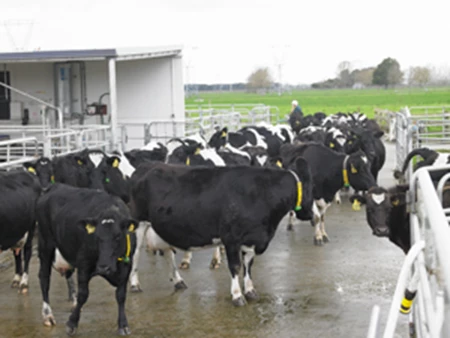Electronic ID
2 min read
Electronic identification (EID) systems in dairy farming consist of a transponder, reader, and data processing unit that communicate via radio signals. This page focuses on radio frequency (RFID) EID systems, detailing their benefits such as improving work efficiency, simplifying data collection, and providing valuable information for decision-making. Features of EID systems, including the elements involved and compatibility with different environments, are also described. The page offers guidance on considerations before purchasing an EID system, like compatibility and future-proofing. Finally, it outlines various automatic tasks made possible or easier through the use of EID.
Electronic identification (EID) systems consist of a transponder, a reader and a data processing unit. Coded signals are sent by radio frequency or infrared light between the components of the system.
The information in this section focuses on radio frequency (RFID) forms of electronic identification and is intended to support a farmer’s own research on commercially available products. Product reliability and the how they integrate with various control systems varies widely.
Improving work efficiency. By reducing the labour required for identifying cows; eliminating human error associated with ear tag reading; producing valuable management information and reducing the amount of animal handling.
Simplifying collection of data. EID systems can be linked to dairy management software which can collect information from milk metering systems, walk-over weighers etc, providing ease of management and information for decision making.

Typically there are three elements to the identification system: a transponder (ear tag, leg band, neck pendant, implant or rumen bolus); a reader (transceiver); and a data processing unit (e.g. laptop or handheld). Most electronic cow identification systems used in New Zealand use radio signals to transfer the information from tag to reader (RFID). These systems have the advantage of being able to work in dirty, dusty and moist environments and do not require line of sight.
Software and databases link EID codes to animals, store that information, and enable decision making and data sharing. Data may be managed locally or transferred to third party databases. When linked to management databases, EID can integrate with computerised management systems that can record the information and then use it to carry out many management tasks automatically.

Now’s the perfect time to check in, plan, and set up for a strong season. We’ve pulled together smart tips and tools to help you stay ahead all winter long.
Whether you prefer to read, listen, or download handy guides, we’ve got you covered with trusted tools to support your journey every step of the way.
Put our proven strategies and seasonal tools to work. Boost production, support animal health and watch your profits hum.
Tools that are backed by science, shaped by farmers and made for this season.
That’s Summer Smarts.